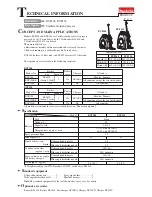
- 4 -
B. Adjustments
The desired pattern, volume of fluid output and fine atomization can easily be obtained by regulating
the Pattern Adjusting Knob, Fluid Adjusting Knob and Air Adjusting Knob.
PATTERN ADJUSTMENT:
Turning Pattern Adjusting Knob to the right until tight will make spray pattern round,
or turning left make spray pattern ellipse.
FLUID (PAINT) ADJUSTMENT:
Turn the Fluid Adjusting Knob clockwise will decrease the volume of fluid
output and counter-clockwise will increase fluid output.
AIR ADJUSTMENT:
Turning the Air Adjusting Knob clockwise will decrease the air volume. And
counter-clockwise will increase the air volume.
C. Operation
1. Begin spraying. Always keep the gun at right angles to the work.
2. Keep the nozzle about 6 to 12 inches from the work surface. Grip the gun keeping perpendicular with
spraying area then move it parallel for several times, stopping gun movement in mid-stroke will cause a
build up of paint and result in runs. Do not fan the gun from side to side while painting. This will cause a
build-up of paint in the center of the stroke and an insufficient coating at each end.
3. Trigger the gun properly. Start the gun moving at the beginning of the stroke
BEFORE SQUEEZING THE
TRIGGER
and release the trigger
BEFORE STOPPING GUN MOVEMENT
at the end of the stroke. This
procedure will blend each stroke with the next without showing overlap or unevenness.
4. The amount of paint being applied can be varied by the speed of the stroke, distance from the surface and
adjustment of the fluid control knob.
5. Overlap strokes just enough to obtain an even coat.
6.
NOTE:
Two thin coats of paint will yield better results and have less chance of runs than one heavy layer.
7. Use a piece of cardboard as a shield to catch overspray at the edges of the work to protect other surfaces.
5. Maintenance
Incomplete cleaning could cause function failures and a degradation of the fan form.
1.
Remove any remaining paint by pouring it into another container.
2.
Disassemble the spray gun making sure to remove the needle before disassembling the nozzle to
avoid damage to the housing of the nozzle closure.
3.
Clean all the paint passages and the nozzle. Clean the other components using a brush soaked in
solvent.
4.
Reassemble the spray gun and spray a small quantity of solvent to eliminate all the residues in the
paint passages.
WARNING:
NEVER USE METAL OR OTHER OBJECTS THAT COULD DAMAGE THE HOLES IN THE NOZZLE AND CAP. NEVER
IMMERSE THE SPRAY GUN COMPLETELY IN SOLVENT. NEVER USE COMPONENTS OR PARTS THAT ARE NOT
MANUFACTURER ORIGINALS.

























